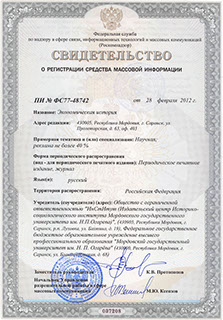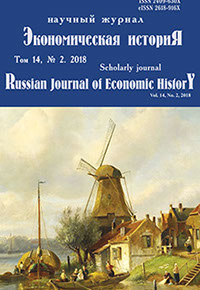Экономическая историЯ
Russian Journal of Economic History
ISSN 2409-630X (Print)
ISSN 2618-916X (Online)
Expert board:
- Scientific Council of RAS on economic history;
- Research and Educational Center «The economic history of Central Russia and the Middle Volga region» of Ogarev Mordovia State University;
- Center of Economic History of Lomonosov Moscow State University
Navigation
Certificate of registration

ISSN 2409-630X (Print), ISSN 2618-916X (Online)
DOI: 10.15507/2409-630X.041.014.201802.179-187
Elena Z. Gracheva1,
Mordovian State Pedagogical Institute (Saransk, Russia),
e-mail: p629@yandex.ru
ORCID: https://orcid.org/0000-0002-2758-8065.
Аleksandr V. Martynenko2
Mordovian State Pedagogical Institute (Saransk, Russia),
e-mail: arkanaddin@mail.ru
ORCID: https://orcid.org/0000-0002-4701-6398.
THE VOLGA REGION WITHIN THE SYSTEM OF RUSSIAN – MIDDLE EASTERN TRADE AND ECONOMIC RELATIONS OF THE XVII–XVIII CENTURIES
Introduction. The Volga region played a key role in trade between Russia and the Middle East (Iran and various Central Asian states) in the 17th and 18th centuries. Its location was extremely advantageous and a contributing factor to its success. The Caspian-Volga trade route played the role of the main transportation artery, which connected Russia and Iran, Transcaucasia, India, and Central Asian khanates. There is a reason why the biggest centers of Russian-Eastern trade: Astrakhan, Kazan, and Makaryev Fair were all situated on the Volga river. Materials and Methods. In the methodological aspect, the article is based on a civilizational approach that accentuates the researcher’s attention on the sociocultural aspects of the stated problem and allows to interpret the economic interaction between Russia and Persia as one of many manifestations of inter-civilization dialogue. Also used was the traditional institutional approach for historical and economic work, representing the economy as part of social systems. In addition, the research presented in this article is also based on a system-complex approach, including such basic elements as structural-functional, hermeneutic, phenomenological and comparative-historical methods. Results. Overall, during this period, the Russian authorities were able to maintain a regime that was favorable for Persian merchants, particularly for Armenian merchants from Julfa, who earned the right to travel freely across Russian territory through to Moscow, along with other privileges – they were also able to access Europe via cities along the Russian border. On the verge of the 17th and the 18th centuries, the movement of goods along the Volga and the Caspian Sea increased significantly. The majority was exported into Europe, but a significant part was sold in Russia: in Moscow, Astrakhan, Kazan, Yaroslavl, and other cities, and also at the Makaryev Fair. Regular contacts between Russian and Eastern merchants gave rise to its own traditions and to an established order of trade operations with a set list of participants. On the one side, there were representatives of the Russian trading guild, which later turned into the guild merchant class, who oftentimes combined trade and production. Their counteragents in trade were Transcaucasian (especially Armenian), Indian, Iranian, and Central Asian traders, authorized representatives, and a multitude of intermediary agents. Overall, the Volga region played a key and strategic role in the system of trade between Russian and Middle East, primarily concerning the states that were located on the modern-day territory of Iran. It was akin to a bridge between civilizations, which facilitated intercultural influences between Russia and Persia.
Keywords: Russia, Iran (Persia), Volga region, fair, trade, the merchant class, trade diaspora.
For citation: Elena Z. Gracheva, Aleksandr V. Martynenko. The Volga Region within the System of Russian – Middle Eastern Trade and Economic Relations of the XVII–XVIII Centuries. Ekonomicheskaya istoriya = Russian Journal of Economic History. 2018; 14(2): 179–187. (In Russ.). DOI: 10.15507/2409-630X.040.014.201801.179-187
© Ogarev Mordovia State University. History and Sociology Institute, 2017
68, Of. 411, Bolshevistskaya St., 430005, The editorial office of the scholarly journal «Russian Journal of Economic History»
Tel.: (8342) 24-25-90; 27-07-11, Fax: (8342) 24-25-90, E-mail: jurnal-econom-hist@isi.mrsu.ru
Designed by A. Napalkov, Email: napalkov@isi.mrsu.ru

